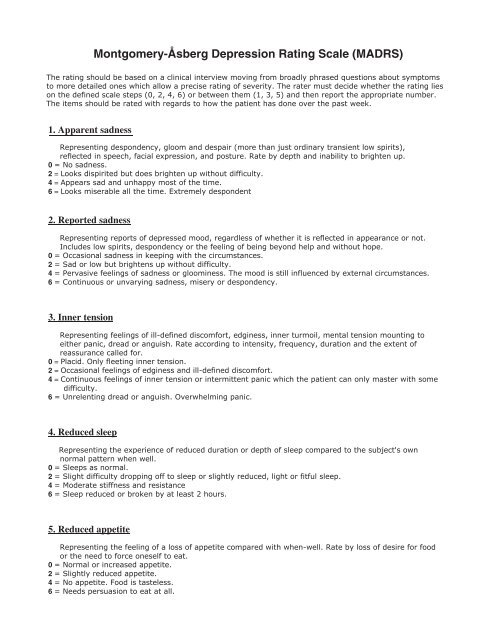Center for Epidemiologic Studies Depression Scale ... - myCME.com
Center for Epidemiologic Studies Depression Scale ... - myCME.com
Center for Epidemiologic Studies Depression Scale ... - myCME.com
You also want an ePaper? Increase the reach of your titles
YUMPU automatically turns print PDFs into web optimized ePapers that Google loves.
Montgomery-Åsberg <strong>Depression</strong> Rating <strong>Scale</strong> (MADRS)The rating should be based on a clinical interview moving from broadly phrased questions about symptomsto more detailed ones which allow a precise rating of severity. The rater must decide whether the rating lieson the defined scale steps (0, 2, 4, 6) or between them (1, 3, 5) and then report the appropriate number.The items should be rated with regards to how the patient has done over the past week.1. Apparent sadnessRepresenting despondency, gloom and despair (more than just ordinary transient low spirits),reflected in speech, facial expression, and posture. Rate by depth and inability to brighten up.0 = No sadness.2 = Looks dispirited but does brighten up without difficulty.4 = Appears sad and unhappy most of the time.6 = Looks miserable all the time. Extremely despondent2. Reported sadnessRepresenting reports of depressed mood, regardless of whether it is reflected in appearance or not.Includes low spirits, despondency or the feeling of being beyond help and without hope.0 = Occasional sadness in keeping with the circumstances.2 = Sad or low but brightens up without difficulty.4 = Pervasive feelings of sadness or gloominess. The mood is still influenced by external circumstances.6 = Continuous or unvarying sadness, misery or despondency.3. Inner tensionRepresenting feelings of ill-defined dis<strong>com</strong><strong>for</strong>t, edginess, inner turmoil, mental tension mounting toeither panic, dread or anguish. Rate according to intensity, frequency, duration and the extent ofreassurance called <strong>for</strong>.0 = Placid. Only fleeting inner tension.2 = Occasional feelings of edginess and ill-defined dis<strong>com</strong><strong>for</strong>t.4 = Continuous feelings of inner tension or intermittent panic which the patient can only master with somedifficulty.6 = Unrelenting dread or anguish. Overwhelming panic.4. Reduced sleepRepresenting the experience of reduced duration or depth of sleep <strong>com</strong>pared to the subject's ownnormal pattern when well.0 = Sleeps as normal.2 = Slight difficulty dropping off to sleep or slightly reduced, light or fitful sleep.4 = Moderate stiffness and resistance6 = Sleep reduced or broken by at least 2 hours.5. Reduced appetiteRepresenting the feeling of a loss of appetite <strong>com</strong>pared with when-well. Rate by loss of desire <strong>for</strong> foodor the need to <strong>for</strong>ce oneself to eat.0 = Normal or increased appetite.2 = Slightly reduced appetite.4 = No appetite. Food is tasteless.6 = Needs persuasion to eat at all.
















